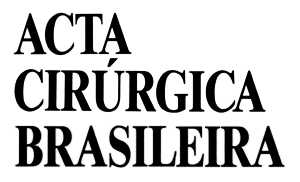Resumo em Português:
OBJETIVO: As estatinas são agentes reconhecidamente hipolipemiantes. Vários estudos têm revelado que eles têm ações pleiotrópicas, como antiinflamatória e imunomoduladora. Tentando-se entender o papel antiinflamatório da sinvastatina na sepse, foram analisados os níveis de citocinas pró-inflamatórias e contagem de leucócitos em modelo de sepse abdominal por ligadura e punção do ceco (LPC) em ratos. MÉTODOS: Foram utilizados 28 ratos Wistar pesando 285±12g, assim divididos: grupo sepse (n=14), submetidos a LPC e grupo sham (n=14), submetidos a laparotomia e manipulação suave do ceco. No grupo LPC/sinvastatina (n=7) os ratos receberam 10mg/kg de sinvastatina via oral 18 e 2 horas antes da LPC e no grupo LPC/salina (n=7) os ratos receberam injeção oral de solução salina 0,9 %. Os animais dos grupos sham/sinvastatina (n=7) e sham/salina (n=7) receberam o mesmo tratamento. Dosagem de TNF-alfa, IL-1beta e IL-6 por ELISA e contagem de leucócitos totais, neutrófilos, linfócitos e eosinófilos foram realizadas em todos os animais. Análise estatística foi feita pelo ANOVA e teste de Tukey, com significância p<0,05. RESULTADOS: Ficou demonstrado que as dosagens de TNF-alfa, IL-1beta e IL-6 atingiram valores de 364,8±42pg/ml; 46,3±18pg/ml e 28,4±13pg/ml no grupo submetido à sepse e tratados com sinvastatina, significantemente mais baixos do que no grupo sepse não tratados (778,5±86pg/ml; 176,9±46pg/ml; 133,6±21 pg/ml, respectivamente). O mesmo ocorreu na contagem de leucócitos totais e neutrófilos. CONCLUSÃO: A sinvastatina mostrou ação anti-inflamatória em ratos Wistar, diminuiu níveis de citocinas e leucócitos, sugerindo uso potencial na prevenção ou atenuação dos efeitos da sepse abdominal.
Resumo em Inglês:
PURPOSE: Statins are widely recognized as hypolipemic drugs, but some studies have observed anti-inflammatory and immunomodulatory effects, known as pleiotropic. The aims of this work was to study possible anti-inflammatory effects of simvastatin in abdominal sepsis. Serum pro-inflammatory cytokines and leukocytes count were determined in an experimental model of abdominal sepsis, using cecal ligation and puncture (CLP) in rats. METHODS: Twenty eigth Wistar rats weighing 285±12g were randomly divided in: CLP/Sinvastatin rats (n=7), treated with 10 mg/Kg of oral simvastatin 18 and 2 hs berofe CLP; CLP/Saline group rats (n=7), treated with oral saline; group Sham/Simvastatin (n=7), treated with simvastatin, and group Sham/Saline (n=7), treated with saline. Serum TNF-alpha, IL-1beta and IL-6 by ELISA and total leukocytes, neutrophils, lymphocytes, and eosinophils were determined 24 hs after CLP. ANOVA and Tukey test were used considering significant p<0.05. RESULTS: It was demonstrated that serum TNF-alpha, IL-1beta and IL-6 were respectively 364,8±42pg/mL; 46,3±18pg/mL and 28,4±13pg/mL in CLP/Sinvastatin rats, significantly lower (p<0.05) than in group CLP/Saline (778,5±86pg/ml; 176,9±46pg/ml; 133,6±21 pg/ml, respectively). The same results were observed in total leukocytes and neutrophils counts. CONCLUSION: These results clearly demonstrate that simvastatin is an effective agent that reduces cytokines levels and leukocyte count in sepsis, independently of its well-known lipid-lowering effects. Thus, HMG-CoA reductase inhibitors like simvastatin have important anti-inflammatory effects in abdominal sepsis in rats.
